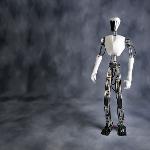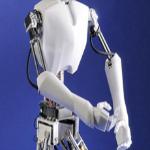06 December 2010

Photo: Virginia Tech
The ultimate goal of the CHARLI project is to develop full-size, autonomous robots that can take on the dullest, dirtiest and most dangerous jobs that humans now do.
The world of tomorrow - at least according to writers of science fiction - includes human-like robots that interact with people and help society in many ways. That future is becoming a reality at Virginia Tech in Blackburg, Virginia.
Meeting CHARLI
"I can walk like you with two legs. I can see and recognize objects with my two camera eyes. I can track objects and grasp them with my hand. And most of all, I can play a game of soccer," says CHARLI, 1.4-meter-tall robot, made of shiny black metal and white plastic, who can also stretch his arms. His name is an acronym for Cognitive Humanoid Autonomous Robot with Learning Intelligence.
Billed as the nation's first full-sized autonomous walking humanoid robot, CHARLI was developed over the past year-and-a-half at Virginia Tech's Robotics and Mechanisms Laboratory. A team of students designed and built it for just $20,000.

Virginia Tech
Carbon-fiber tubes and custom-milled aluminum parts give CHARLI a strong but lightweight body.Dennis Hong, who heads RoMeLa, as the lab is known, says that's unheard of in the world of robotics.
"Because you had a very, very small amount of seed money, $20,000, we had to be really creative," says Hong. "How can you create a full-size, fully autonomous robot in such a short period of time with such a small amount of money? So, instead of using quote, unquote, conventional methods, we had to be innovative and come up with different types of solutions."
Off the shelf
Although CHARLI's circuit boards and some of the power boards are custom-designed, the robot is made up of mostly off-the-shelf parts.
"For example, most of the shoulder motors you can buy from the internet, these are motors," says Taylor Pesek, a junior engineering student from Ohio. He helped develop and manufacture white covers for CHARLI's torso and arms to make it look more human while also protecting the electronics underneath. "Right now, we're using vacuum-form plastic. It's really easy to manufacture. It's relatively impact resistant and the thicker material that we're using right now also helps resist cracking and abrasion."
CHARLI can walk forward, backward, and sideways, and it can vary the length of its stride. But it can only walk on a hard, flat surface. RoMeLa is developing a heavier version, CHARLI-H, that will be able to handle various surfaces.
Hong has his eye on Robocop 2050 - a futuristic, international competition that's still 40 years away - which will pit full-sized, autonomous robots against that year's World Cup soccer champions. But he expects more from CHARLI than a win on the soccer field.
"The ultimate goal of our CHARLI project is to make a full-size autonomous human robots that can eventually help people, help the society," he says.

Virginia Tech
Virginia Tech will soon post instructions for building one of its robots online so people can download, reprogram, upload and improve it.The three Ds
The team is focusing its research on what is known as the three Ds: dull, dirty, and dangerous jobs.
"So those are the areas we want to send robots instead of humans," says Hong, "like in a nuclear reactor. We need to clean up all the nuclear waste, we send in robots. In the war zone, there are roadside bombs, very dangerous. They send in the robots to do the work. In a factory, repetitive tasks. We humans, we don't want to do that, so we send in the robots."
December is a big month for RoMeLa. The Virginia Tech lab begins work on a project using robots to fight fires on naval ships. Another grant will allow Hong and his team to put the instructions for building another one of their robots online.
"You can download instructions," says Hong. "You can build your own if you want to. All the software is there, you can download it, reprogram it, upload, and improve it."
The build-your-own-robot program is called DARwIn-OP. That's short for Dynamic Anthropomorphic Robot with Intelligence-Open Platform. It makes its debut, along with the legs and feet of the next generation of CHARLI, at the International Humanoid Robotics Conference in Nashville, Tennessee this month.